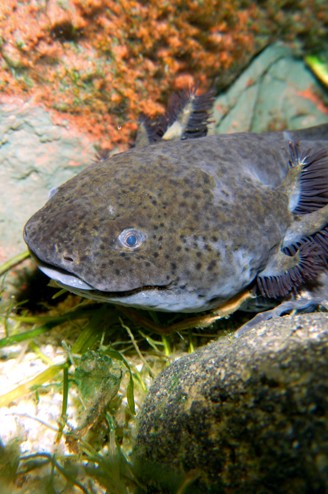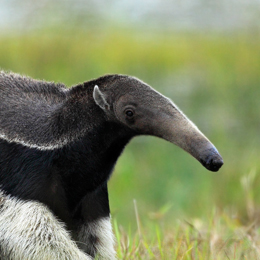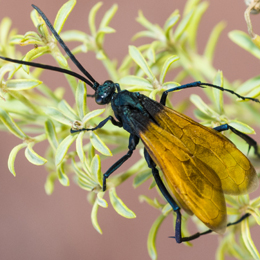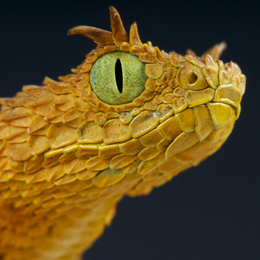Physical Description
Axolotl is a paedomorphic aquatic salamander which means it retains its larval characteristics once it reaches adulthood or its reproductive stage. Adult axolotls vary in length with an average size between 15 and 45 cm (0.5-1.5 ft). The Mexican aquatic salamander carries an approximate weight of 0.06 – 0.1 kg. However, in captivity, the amphibian may weigh as much as 0.5 kg.
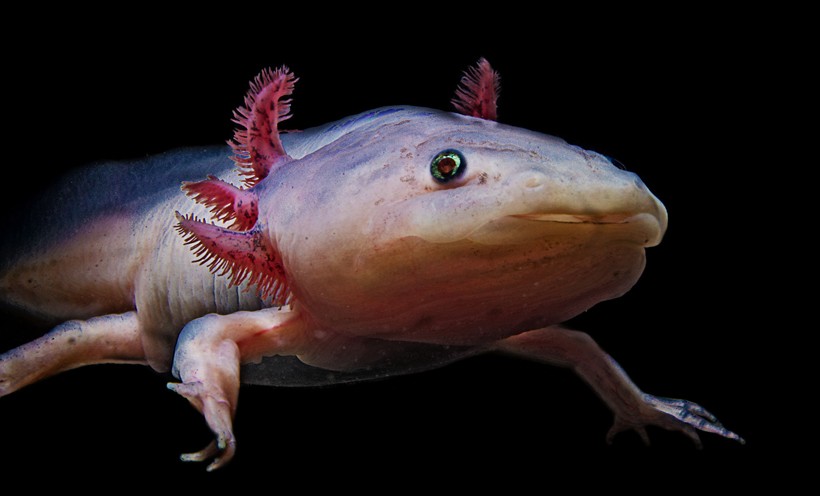
Axolotl Albino coloring (white/golden skin tone with gold eyes)
?
Image credits: Luc Stacey/Shutterstock
Axolotls possess typical features of salamander larvae that include external gills and a caudal fin that extends from behind the head reaching till the vent. They are gilled amphibians that showcase a cartilaginous skeleton that doesn’t completely become calcified. Like most amphibians Axolotls respire through their gills but are also able to respire through their skin like most of the amphibians. Laboratory-bred specimens of the Axolotl exhibit various skin tones out of which four basic mutant colors persist – Albino (white/golden skin tone with gold eyes), Leucistic (pale pink with black eyes), Axanthic (gray with black eyes) and Melanoid (black with an olive tone).
Habitat
The native habitats of the Axolotl are Lake Xochimilco and Lake Chalco although the latter no longer exists since it was artificially drained to avoid annual flooding. Lake Xochimilco in central Mexico is thus the only existing habitat. It is a large, high-altitude lake that reserves an optimum temperature of 68 degrees Fahrenheit.
The Axolotl is a critically endangered species that is almost extinct due to the introduction of invasive species and habitat loss. They are fully aquatic species that prefer freshwater lakes and ponds enriched with heavy vegetation.
Diet & Feeding Habits
The Axolotl preys upon a wide number of smaller species like arthropods, fishes, and mollusks. They primarily eat fishes, mollusks, crustaceans, insect larvae and arthropods found in freshwater lakes and ponds. The Axolotl often preys upon terrestrial worms like bloodworms and black worms, but can also be seen feeding on small freshwater amphibians, feeder fish, salmon eggs, and zooplankton.
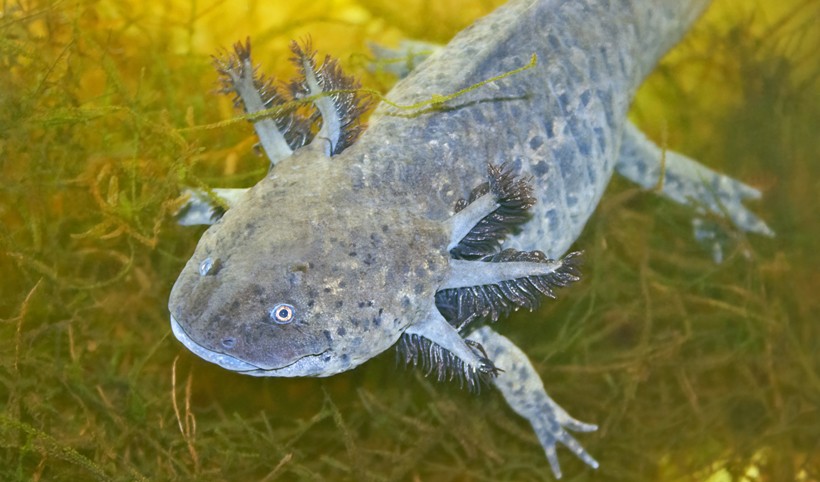
Axolotls are fully aquatic species that prefer freshwater lakes and ponds enriched with heavy vegetation.
?
Image credits: Sombra/Shutterstock
The primary mode of feeding is by suction. In this process, the rakers interlock to close the gill slits while taking in food. They are voracious feeders and can easily consume earthworms, bloodworms, shrimp, tadpoles and feeder fish. Black worms form a major part of their diet since they are aquatic relatives of earthworms. The Axolotl may engulf gravel that acts as gastrolith for improved digestion (grinding function) and also to regulate the buoyancy control. The Axolotl has a few predators in the wild of which the Tilapia and the Carp are the major threats.
Anatomy
A unique characteristic of the Axolotl is its anatomy, exhibiting a phenomenon known as ‘neoteny’. This medium sized amphibian that is part of the family Ambystoma is found in a complex habitat of south-central Mexico. The word Axolotl comes from Aztec origins where 'atl' means water and 'xolotl' means dog.
A typical adult Axolotl possesses a large, wide head and lidless eyes. Males can be identified by the presence of a narrow head, a longer tail and a swollen cloaca that are lined with papillae. Females possess a round, plump body and a smaller cloaca. On average, the length of a female is smaller as compared to their male counterparts. Axolotls are known to possess four pigmentation genes that render different color variants during mutation. They have a permeable skin and are usually found in albino form since they spend most of their time hiding under rocks.
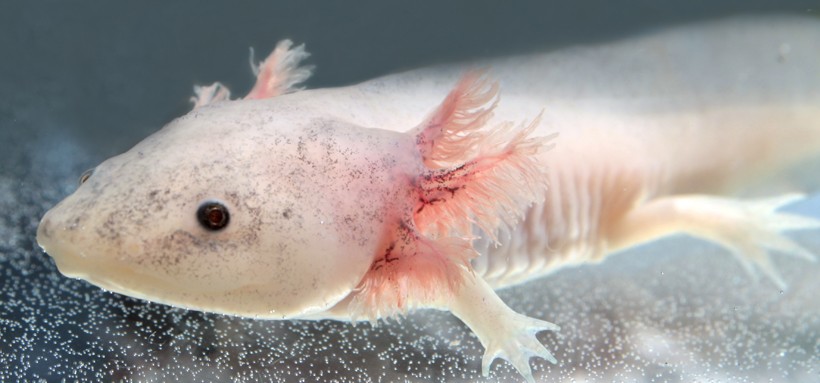
The axolotl is a neotenic salamander that retains certain traits of its larval stage in adulthood
?
Image credits: Kazakov Maksim/Shutterstock
External gills of the Axolotl are lined with fine filaments, also known as fimbriae, which help to increase the surface area for any kind of gaseous exchange. There are four gill slits hidden underneath feathery external gills that are lined with gill rakers. The external gills are primarily used for respiration. However these gills are also used to gulp air from the surface, a method which is known as buccal pumping, providing oxygen into their lungs. An adult Axolotl maintains a finned tail which is useful for swimming. They also showcase bilateral symmetry. The limbs are underdeveloped with thin, long digits and barely visible vestigial teeth. Axolotls also have the ability to regenerate their limbs that have become detached or damaged.
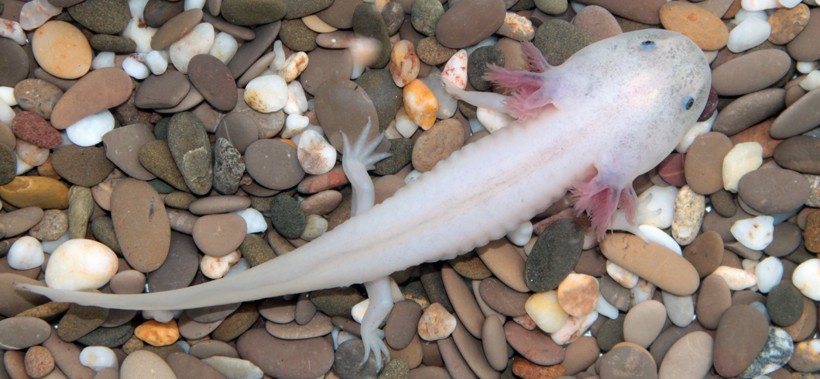
A unique characteristic of the Axolotl is its anatomy, exhibiting a phenomenon known as ‘neoteny’.
?
Image credits: Kazakov Maksim/Shutterstock
Despite having a tadpole-like appearance, the unique characteristic of the Axolotl is its ability to retain certain larval features like its tadpole-like dorsal fin. Neoteny is a phenomenon in Axolotls where a metamorphic failure occurs as a result of lack of a certain hormone. This hormone is the thyroid stimulating hormone which produces thyroxin that helps to transform salamanders. Neoteny is known as a form of survival mechanism as developed within the species. This physical adaptation allows the Axolotl to survive in an aquatic habitat that contains marginal food volume and lacks a certain percentage of iodine. Laboratory experiments wherein thyroxin hormone was artificially induced into the species resulted in the metamorphosis of treated Axolotls in a species that resembles a terrestrial plateau tiger salamander.
Reproduction
The Axolotl reaches sexual maturity between 6 months and a year. Sources relate that the breeding season for the species is from March to June. Spawning generally takes place during late winter when the water temperature and daylight levels are favorable. The breeding process begins with the ‘waltz’, which is a friendly dance between a male and female Axolotl to initiate mating. Both amphibians rub or nudges the other’s cloaca region, meanwhile moving in a circle. The male deposits a cone-shaped mass that contains a sperm cap by shaking its tail vigorously for half a minute. The female Axolotl picks the spermatophore with her cloaca by shaking also her tail, initiating thus fertilization.
Around 300 – 1000 eggs are deposited in the water where they are attached to a protective substrate. Eggs are laid individually and are mostly placed on plants or rocky substrates since they provide the perfect cover against natural predators. Hatching of the eggs takes place after 2 weeks or more and the young ones are found to be independent at birth. There is no parental nursing in case of the Axolotl. The young hatchlings learn to fend for themselves and consume micro worms, brine shrimp and daphnia in their juvenile stage. Breeding takes place just once a year in the wild. However under artificial conditions breeding can happen twice or thrice a year.
Behavior
Axolotls are solitary creatures that usually feed at night. They remain active throughout the day where the mornings are spent in search of suitable spawning grounds. They communicate using visual and chemical cues which are prominent during the mating season. They are able to detect electromagnetic fields which help to perceive the distance and type of prey that is present in their environment. Other forms of communication occur by using pheromones which is a chemical signal sent across to active males during the breeding season.
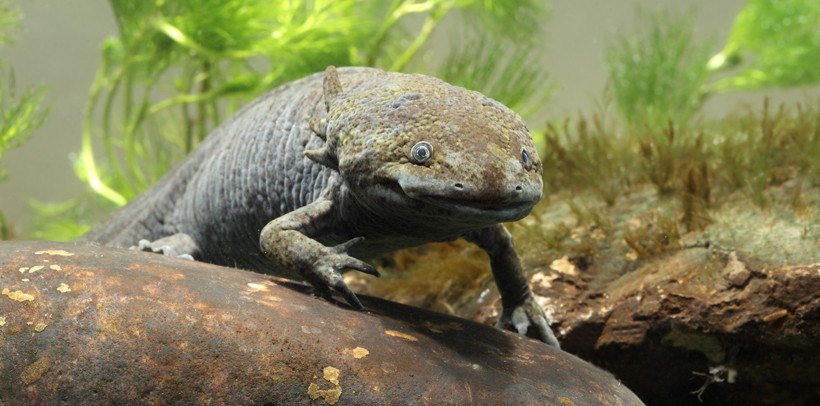
Axolotls communicate using visual and chemical cues which are prominent during the mating season.
?
Image credits: Erni/Shutterstock
Female axolotls leave off pheromones to announce their sexual maturity in order to find suitable mates. Older Axolotls generally supplement their oxygen supply by filling their rudimentary lungs at the surface of the water body.
Neoteny and its Significance
The Axolotl is a universally accepted species that is being used as a model organism to fully understand the phenomenon of ‘neoteny’ in laboratories. Today the Axolotl is being bred in captivity because it is a critically endangered species. Vilem Laufberger from Germany was one of the first to induce artificial metamorphosis in the Axolotl using thyroid hormone injections. It induces the species to grow into a terrestrial tiger salamander. Since then this experiment has been repeated by many biologists to understand the development of the embryo and detect features of its mutated gene. The Axolotl is also an ideal model organism for the study of neural tube closure. This is because the human and axolotl neural plate formation share a few similarities.
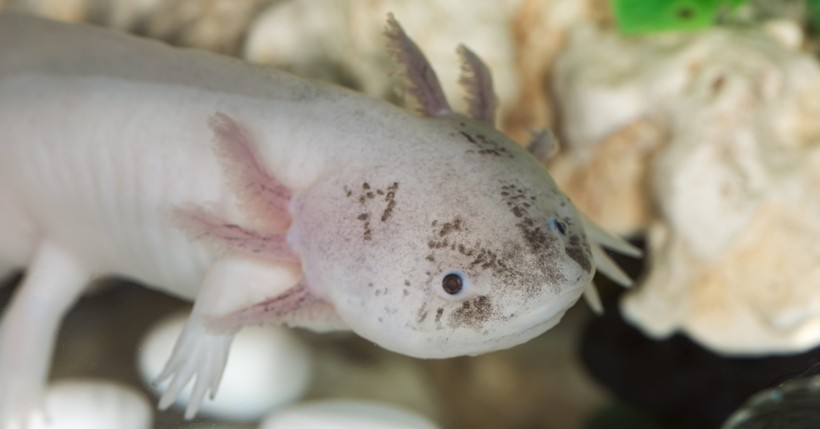
Neoteny is a phenomenon in Axolotls where a metamorphic failure occurs as a result of lack of a certain hormone
?
Image credits: Maslov Dmitry/Shutterstock
A unique feature of the Axolotl is the ability to regenerate. It is capable of regenerating lost appendages like limbs within months and sometimes even vital structures like parts of the brain. The species can also easily accept transplants from other individuals like in the case of eyes and parts of the brain. Metamorphosed individuals generally have reduced ability to regenerate. Therefore, scientists prefer using the Axolotl as a model organism in its neotenic stage for the development of limbs for vertebrates.
Threats
The Axolotl is a critically endangered species because of its extensive use in scientific research. The species has suffered a major population decline after the artificial flooding of Lake Chalco in Central Mexico. A prior estimation (1998) resulted in more than 6000 individuals found in the Lake Xochimilco habitat. By 2008, the number of individuals was reduced to 100, whereas in 2014 less than 1 individual per square kilometer was found. The canals of Lake Xochimilco are polluted with waste by Mexican gondoliers and tourists that travel through the canal in brightly colored party boats. The deteriorating water quality has also become a major reason why the Axolotl population has suffered a massive setback.
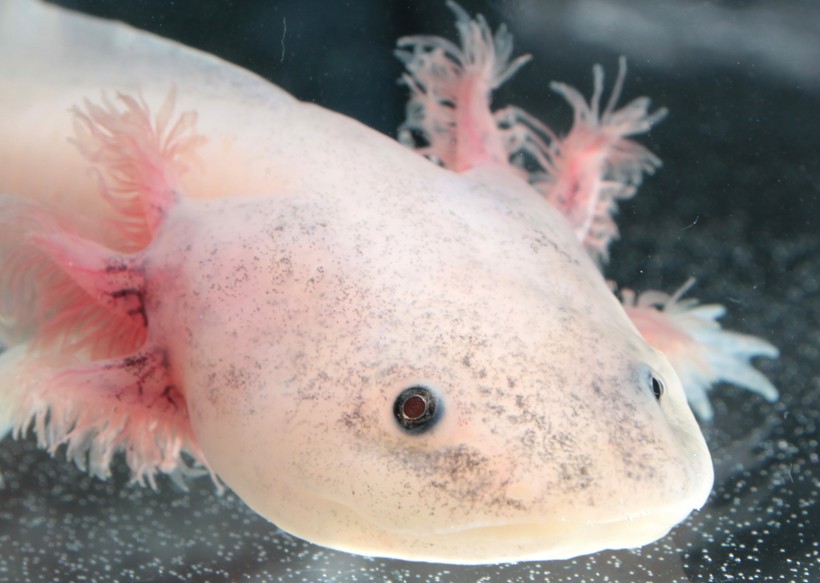
The Axolotl is a critically endangered species with a population of 100 individuals in the wild
?
Image credits: Kazakov Maksim/Shutterstock
Other threats include the introduction of invasive species into their environment due to which there is competition concerning the food resource availability. Non-native organisms have become dangerous predators that eat Axolotl off springs and destroy their nests. Moreover, it has been ascertained that the Axolotl species is hunted for its meat and other body parts. According to reports, a lucrative black market system lures many local and poor fishermen to catch young Axolotls in their nets and deposit the species to certain illegal traders. Finally, Axolotls have become also a popular choice as pets because of their color variants. They are quite docile creatures that are sadly being hunted and sold at illegal pet trade centers.
Funfacts
- The word Axolotl comes from Aztec origins where ‘atl’ means water and ‘xolotl’ means dog.
- The Axolotl is a Mexican neotenic mole salamander that fails to undergo metamorphosis. However they are still able to reproduce themselves in its larval stage.
- The feathery branches that sprout from the sides of the Axolotl are in fact its gills.
- In ancient times, the Axolotl was considered a rare delicacy by the Aztecs and consumed as a form of nutrition.
- In 1787 Francesco Clavigero claimed that the Axolotl is wholesome to eat and tastes much like eel.
- Wild Axolotls are rarely white and are normally greenish brown or black in color.
- The Axolotl shares a mythological significance with the Xolotl, a dog-headed Aztec God.
- Small axolotls that are less than ten centimeters in size showcase cannibalism by eating their weakest member.
- The Axolotl is also referred to as the Mexican Water Monster by the local media.
